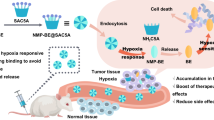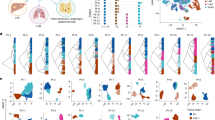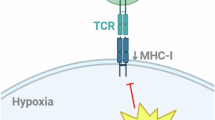Abstract
Hypoxia is a key feature of the tumor microenvironment that leads to the failure of many chemotherapies and induces more aggressive and resistant cancer phenotypes. Up to date, there are very few compounds and treatments that can target hypoxia. BE-43547A2 from Streptomyces sp. was one of the most hypoxia-selective compounds against PANC-1, MCF-7, and K562 cell lines. In this study, we investigated the molecular mechanism underlying the hypoxia selectivity of BE-43547A2 in human pancreatic cancer cells. We showed that BE-43547A2 displayed hypoxia-selective cytotoxicity in five pancreatic cancer cells (PANC-1, Capan-2, MIA PaCa-2, AsPC-1, and PaTu8988T) with IC50 values under hypoxia considerably lower than those under normoxia. We demonstrated that BE-43547A2 is directly bound to eEF1A1 protein in PaTu8988T cells under hypoxia. Furthermore, we revealed that hypoxia significantly elevated the expression levels of HIF1α, FoxO1, and eEF1A1 in the five pancreatic cancer cells; eEF1A1 interacted with FoxO1 in the cytoplasm, which was disrupted by BE-43547A2 followed by the nuclear translocation of FoxO1 and ultimate inhibition of JAK/STAT3 signaling pathway under hypoxia. This study reveals that BE-43547A2, targeting eEF1A1, disrupts its interaction with FoxO1 in human pancreatic cancer cells under hypoxia. This compound could serve as a potential hypoxia-selective therapy.
This is a preview of subscription content, access via your institution
Access options
Subscribe to this journal
Receive 12 print issues and online access
$259.00 per year
only $21.58 per issue
Buy this article
- Purchase on SpringerLink
- Instant access to full article PDF
Prices may be subject to local taxes which are calculated during checkout







Similar content being viewed by others
References
Siegel RL, Miller KD, Jemal A. Cancer statistics, 2016. CA Cancer J Clin. 2016;66:7–30.
Park W, Chawla A, O’Reilly EM. Pancreatic cancer: a review. JAMA. 2021;326:851–62.
Luo W, Tao J, Zheng L, Zhang T. Current epidemiology of pancreatic cancer: challenges and opportunities. Chin J Cancer Res. 2020;32:705–19.
Manoochehri Khoshinani H, Afshar S, Najafi R. Hypoxia: a double-edged sword in cancer therapy. Cancer Invest. 2016;34:536–45.
Lamouille S, Xu J, Derynck R. Molecular mechanisms of epithelial-mesenchymal transition. Nat Rev Mol Cell Biol. 2014;15:178–96.
Jing X, Yang F, Shao C, Wei K, Xie M, Shen H, et al. Role of hypoxia in cancer therapy by regulating the tumor microenvironment. Mol Cancer. 2019;18:157.
Serocki M, Bartoszewska S, Janaszak-Jasiecka A, Ochocka RJ, Collawn JF, Bartoszewski R. miRNAs regulate the HIF switch during hypoxia: a novel therapeutic target. Angiogenesis. 2018;21:183–202.
Vaupel P, Thews O, Hoeckel M. Treatment resistance of solid tumors: role of hypoxia and anemia. Med Oncol. 2001;18:243–59.
Karakashev SV, Reginato MJ. Progress toward overcoming hypoxia-induced resistance to solid tumor therapy. Cancer Manag Res. 2015;7:253–64.
Kumar V, Gabrilovich DI. Hypoxia-inducible factors in regulation of immune responses in tumour microenvironment. Immunology. 2014;143:512–9.
Baran N, Konopleva M. Molecular pathways: hypoxia-activated prodrugs in cancer therapy. Clin Cancer Res. 2017;23:2382–90.
Sun Y, Ding Y, Li D, Zhou R, Su X, Yang J, et al. Cyclic depsipeptide BE-43547A2: synthesis and activity against pancreatic cancer stem cells. Angew Chem Int Ed Engl. 2017;56:14627–31.
Villadsen NL, Jacobsen KM, Keiding UB, Weibel ET, Christiansen B, Vosegaard T, et al. Synthesis of ent-BE-43547A(1) reveals a potent hypoxia-selective anticancer agent and uncovers the biosynthetic origin of the APD-CLD natural products. Nat Chem. 2017;9:264–72.
Jacobsen KM, Villadsen NL, Tørring T, Nielsen CB, Salomón T, Nielsen MM, et al. APD-containing cyclolipodepsipeptides target mitochondrial function in hypoxic cancer cells. Cell Chem Biol. 2018;25:1337–49.e12
Liu C, Wang L, Sun Y, Zhao X, Chen T, Su X, et al. Probe synthesis reveals eukaryotic translation elongation factor 1 alpha 1 as the anti-pancreatic cancer target of BE-43547A2. Angew Chem Int Ed Engl. 2022;61:e202206953.
Guo JS, Li JJ, Wang ZH, Liu Y, Yue YX, Li HB, et al. Dual hypoxia-responsive supramolecular complex for cancer target therapy. Nat Commun. 2023;14:5634.
Chang J, Kim Y, Kwon H. Advances in identification and validation of protein targets of natural products without chemical modification. Nat Prod Rep. 2016;33:719–30.
Jafari R, Almqvist H, Axelsson H, Ignatushchenko M, Lundback T, Nordlund P, et al. The cellular thermal shift assay for evaluating drug target interactions in cells. Nat Protoc. 2014;9:2100–22.
Pai MY, Lomenick B, Hwang H, Schiestl R, McBride W, Loo JA, et al. Drug affinity responsive target stability (DARTS) for small-molecule target identification. Methods Mol Biol. 2015;1263:287–98.
Liao LX, Song XM, Wang LC, Lv HN, Chen JF, Liu D, et al. Highly selective inhibition of IMPDH2 provides the basis of antineuroinflammation therapy. Proc Natl Acad Sci USA. 2017;114:E5986–E94.
Li J, Li S, Guo J, Li Q, Long J, Ma C, et al. Natural product micheliolide (MCL) irreversibly activates pyruvate kinase M2 and suppresses leukemia. J Med Chem. 2018;61:4155–64.
Liu CX, Yin QQ, Zhou HC, Wu YL, Pu JX, Xia L, et al. Adenanthin targets peroxiredoxin I and II to induce differentiation of leukemic cells. Nat Chem Biol. 2012;8:486–93.
Dai J, Liang K, Zhao S, Jia W, Liu Y, Wu H, et al. Chemoproteomics reveals baicalin activates hepatic CPT1 to ameliorate diet-induced obesity and hepatic steatosis. Proc Natl Acad Sci USA. 2018;115:E5896–E905.
Lu X, Kang Y. Hypoxia and hypoxia-inducible factors: master regulators of metastasis. Clin Cancer Res. 2010;16:5928–35.
Johnson DE, O’Keefe RA, Grandis JR. Targeting the IL-6/JAK/STAT3 signalling axis in cancer. Nat Rev Clin Oncol. 2018;15:234–48.
Vogel M, Xie L, Guan H, Tooze R, Maier T, Kostezka U, et al. FOXO1 repression contributes to block of plasma cell differentiation in classical Hodgkin lymphoma. Blood. 2014;124:3118–29.
Mudassar F, Shen H, O’Neill G, Hau E. Targeting tumor hypoxia and mitochondrial metabolism with anti-parasitic drugs to improve radiation response in high-grade gliomas. J Exp Clin Cancer Res. 2020;39:208.
Fu J, Li T, Yang Y, Jiang L, Wang W, Fu L, et al. Activatable nanomedicine for overcoming hypoxia-induced resistance to chemotherapy and inhibiting tumor growth by inducing collaborative apoptosis and ferroptosis in solid tumors. Biomaterials. 2021;268:120537.
Yu JM, Sun W, Wang ZH, Liang X, Hua F, Li K, et al. TRIB3 supports breast cancer stemness by suppressing FOXO1 degradation and enhancing SOX2 transcription. Nat Commun. 2019;10:5720.
Yin H, Wang X, Zhang X, Zeng Y, Xu Q, Wang W, et al. UBE2T promotes radiation resistance in non-small cell lung cancer via inducing epithelial-mesenchymal transition and the ubiquitination-mediated FOXO1 degradation. Cancer Lett. 2020;494:121–31.
Tang Y, Jiang L, Zhao X, Hu D, Zhao G, Luo S, et al. FOXO1 inhibits prostate cancer cell proliferation via suppressing E2F1 activated NPRL2 expression. Cell Biol Int. 2021;45:2510–20.
Ide H, Goto T, Teramoto Y, Mizushima T, Jiang G, Nagata Y, et al. FOXO1 inactivation induces cisplatin resistance in bladder cancer. Cancer Sci. 2020;111:3397–400.
Jazurek-Ciesiolka M, Janikiewicz J, Dobrzyn P, Dziewulska A, Kozinski K, Dobrzyn A. Oleic acid increases the transcriptional activity of FoxO1 by promoting its nuclear translocation and β-catenin binding in pancreatic β-cells. Biochim Biophys Acta Mol Basis Dis. 2019;1865:2753–64.
Yan Y, Huang H. Interplay among PI3K/AKT, PTEN/FOXO and AR signaling in prostate cancer. Adv Exp Med Biol. 2019;1210:319–31.
Chen J, Lu Y, Tian M, Huang Q. Molecular mechanisms of FOXO1 in adipocyte differentiation. J Mol Endocrinol. 2019;62:R239–R53.
Bouchart C, Navez J, Closset J, Hendlisz A, Van Gestel D, Moretti L, et al. Novel strategies using modern radiotherapy to improve pancreatic cancer outcomes: toward a new standard? Ther Adv Med Oncol. 2020;12:1758835920936093.
Ding C, Li Y, Xing C, Zhang H, Wang S, Dai M. Research progress on slit/robo pathway in pancreatic cancer: emerging and promising. J Oncol. 2020;2020:2845906.
Olivares O, Mayers J, Gouirand V, Torrence M, Gicquel T, Borge L, et al. Collagen-derived proline promotes pancreatic ductal adenocarcinoma cell survival under nutrient limited conditions. Nat Commun. 2017;8:16031.
Hollinshead K, Parker S, Eapen V, Encarnacion-Rosado J, Sohn A, Oncu T, et al. Respiratory supercomplexes promote mitochondrial efficiency and growth in severely hypoxic pancreatic cancer. Cell Rep. 2020;33:108231.
Graham K, Unger E. Overcoming tumor hypoxia as a barrier to radiotherapy, chemotherapy and immunotherapy in cancer treatment. Int J Nanomed. 2018;13:6049–58.
Soares DC, Abbott CM. Highly homologous eEF1A1 and eEF1A2 exhibit differential post-translational modification with significant enrichment around localised sites of sequence variation. Biol Direct. 2013;8:29.
Andersen GR, Nissen P, Nyborg J. Elongation factors in protein biosynthesis. Trends Biochem Sci. 2003;28:434–41.
Abbas W, Kumar A, Herbein G. The eEF1A proteins: at the crossroads of oncogenesis, apoptosis, and viral infections. Front Oncol. 2015;5:75.
Anand N, Murthy S, Amann G, Wernick M, Porter LA, Cukier IH, et al. Protein elongation factor EEF1A2 is a putative oncogene in ovarian cancer. Nat Genet. 2002;31:301–5.
Ejiri S. Moonlighting functions of polypeptide elongation factor 1: from actin bundling to zinc finger protein R1-associated nuclear localization. Biosci Biotechnol Biochem. 2002;66:1–21.
Abbott CM, Proud CG. Translation factors: in sickness and in health. Trends Biochem Sci. 2004;29:25–31.
Lamberti A, Caraglia M, Longo O, Marra M, Abbruzzese A, Arcari P. The translation elongation factor 1A in tumorigenesis, signal transduction and apoptosis: review article. Amino Acids. 2004;26:443–8.
Sasikumar AN, Perez WB, Kinzy TG. The many roles of the eukaryotic elongation factor 1 complex. Wiley Interdiscip Rev RNA. 2012;3:543–55.
Yu H, Lee H, Herrmann A, Buettner R, Jove R. Revisiting STAT3 signalling in cancer: new and unexpected biological functions. Nat Rev Cancer. 2014;14:736–46.
Wang T, Fahrmann JF, Lee H, Li YJ, Tripathi SC, Yue C, et al. JAK/STAT3-regulated fatty acid beta-oxidation is critical for breast cancer stem cell self-renewal and chemoresistance. Cell Metab. 2018;27:1357.
Acknowledgements
We acknowledge the support of the National Natural Science Foundation of China (No. 82273794, No. 81903456 to YHD), Guangzhou Laboratory (GZNL2023A01002), and the Natural Science Foundation of Tianjin (No. 20JCQNJC02080 to YHD).
Author information
Authors and Affiliations
Contributions
CL (刘璨) performed most of the cellular, biochemical protein purification, and animal experiments. LW conducted the synthesis of BE-43547A2 probe and NMP-BE-43547A2 citrate. GJL and YJS synthesized BE-43547A2 probe and NMP-BE-43547A2 citrate. CL (刘灿), MMW, and YJ contributed to the cellular and animal experiments. HG and YXL contributed to protein purification and animal experiments. YHD and YC initiated the project, led the project team, designed the experiment plans, analyzed the results. CL (刘璨) , YC, and YHD wrote the manuscript.
Corresponding authors
Ethics declarations
Competing interests
Meng-meng Wang was an employee of Accendatech Co., Ltd and had no commercial interests.
Supplementary information
Rights and permissions
Springer Nature or its licensor (e.g. a society or other partner) holds exclusive rights to this article under a publishing agreement with the author(s) or other rightsholder(s); author self-archiving of the accepted manuscript version of this article is solely governed by the terms of such publishing agreement and applicable law.
About this article
Cite this article
Liu, C., Liu, C., Liu, Gj. et al. BE-43547A2 exerts hypoxia-selective inhibition on human pancreatic cancer cells through targeting eEF1A1 and disrupting its association with FoxO1. Acta Pharmacol Sin 46, 1433–1444 (2025). https://doi.org/10.1038/s41401-024-01461-y
Received:
Accepted:
Published:
Issue date:
DOI: https://doi.org/10.1038/s41401-024-01461-y



